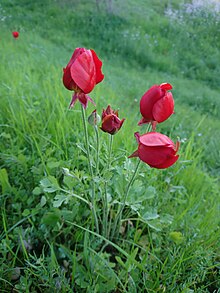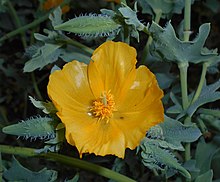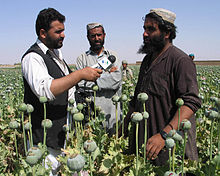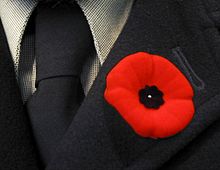Poppy


A poppy is a
Description

Poppies are

Poppies belong to the subfamily Papaveroideae of the family Papaveraceae, which includes the following genera:
- Papaver – Papaver rhoeas, Papaver somniferum, Papaver orientale, Papaver nudicaule, Papaver cambricum
- Eschscholzia – Eschscholzia californica
- Meconopsis – Meconopsis napaulensis
- Glaucium - the horned poppies including Glaucium flavum and Glaucium corniculatum
- Stylophorum – celandine poppy
- Argemone – prickly poppy
- Romneya – matilija poppy and relatives
- Canbya – pygmy poppy
- Stylomecon– wind poppy
- Arctomecon – desert bearpaw poppy
- Hunnemannia – tulip poppy
- Dendromecon – tree poppy
Uses and cultivation

The flowers of most poppy species are attractive and are widely cultivated as annual or perennial ornamental plants. This has resulted in a number of commercially important cultivars, such as the Shirley poppy, a cultivar of Papaver rhoeas and semi-double or double (flore plena) forms of the opium poppy Papaver somniferum and oriental poppy (Papaver orientale). Poppies of several other genera are also cultivated in gardens.[citation needed]

A few species have other uses, principally as sources of drugs and foods. The
.Traditional medicine
Poppy seeds contain small quantities of both morphine and codeine,[5] which are pain-relieving drugs. Poppy seeds and fixed oils can also be nonnarcotic because when they are harvested about twenty days after the flower has opened, the morphine is no longer present.[4] Poppy cultivation is strictly regulated worldwide, with the exception of India where opium gum, which also contains the analgesic thebaine, is legally produced.[6]
History
Papaver somniferum was domesticated by the indigenous people of Western and Central Europe between 6000 and 3500 BC.[7] However, it is believed that its origins may come from the Sumerian people, where the first use of opium was recognized.[8] Poppies and opium made their way around the world along the silk road.[9] Juglets resembling poppy seed pods have been discovered with trace amounts of opium and the flower appeared in jewelry and on art pieces in Ancient Egypt, dated 1550–1292 BC.[10][11]
The eradication of poppy cultivation came about in the early 1900s through international conferences due to safety concerns associated with the production of opium. In the 1970s the American war on drugs targeted Turkish production of the plant, leading to a more negative popular opinion of the U.S.[12]
In culture
The girl's given name "Poppy" is taken from the name of the flower.[13]
A poppy flower is depicted on the
Canada has issued special quarters (25-cent coins) with a red poppy on the reverse in 2004, 2008, 2010, and 2015. The 2004 Canadian "poppy" quarter was the world's first coloured circulation coin.[15]
Symbolism

Poppies have long been used as a symbol of sleep, peace, and death: Sleep because the opium extracted from them is a sedative, and death because of the common blood-red colour of the red poppy in particular.[16] In Greek and Roman myths, poppies were used as offerings to the dead.[17] Poppies used as emblems on tombstones symbolize eternal sleep. This symbolism was evoked in L. Frank Baum's 1900 children's novel The Wonderful Wizard of Oz, in which a magical poppy field threatened to make the protagonists sleep forever.[17] A second interpretation of poppies in Classical mythology is that the bright scarlet colour signifies a promise of resurrection after death.[18]
Red-flowered poppy is unofficially considered the national flower of the Albanians in Albania, Kosovo and elsewhere. This is due to its red and black colours, the same as the colours of the flag of Albania. Red poppies are also the national flower of Poland. The California poppy, Eschscholzia californica, is the state flower of California.[19]
The powerful symbolism of Papaver rhoeas has been borrowed by various advocacy campaigns, such as the
Wartime remembrance

The poppy of wartime remembrance is Papaver rhoeas, the red-flowered corn poppy. This poppy is a common plant of disturbed ground in Europe and is found in many locations, including Flanders, which is the setting of the famous poem "In Flanders Fields" by the Canadian surgeon and soldier John McCrae. In Canada, the United Kingdom, Australia, South Africa and New Zealand, artificial poppies (plastic in Canada, paper in the UK, Australia, South Africa, Malta and New Zealand) are worn to commemorate those who died in war. This form of commemoration is associated with Remembrance Day, which falls on November 11. In Canada, Australia and the UK, poppies are often worn from the beginning of November through to the 11th, or Remembrance Sunday if that falls on a later date. In New Zealand and Australia, soldiers are also commemorated on ANZAC day (April 25),[20] although the poppy is still commonly worn around Remembrance Day. Wearing of poppies has been a custom since 1924 in the United States.[21] Moina Michael of Georgia is credited as the founder of the Memorial Poppy in the United States.[22][23][24]
Artificial poppies (called "Buddy Poppies") are used in the veterans' aid campaign by the Veterans of Foreign Wars, which provides money to the veterans who assemble the poppies and various aid programs to veterans and their families.[25]
See also
References
- ISBN 0444996265
- ^ Dorothy Hodges (1952). The pollen loads of the honeybee. Bee Research Association Ltd., London.
- ISBN 00-705-30815. p. 388-393.
- ^ ISBN 00-705-30815. p. 388-393
- PMID 9800363.
- ^ "Licensed cultivation of opium | Department of Revenue | Ministry of Finance | Government of India". dor.gov.in. Retrieved 2022-11-17.
- ISBN 978-0-393-03891-0.
- PMID 8390660.
- ^ "Opium Poppy: History". www.deamuseum.org. Retrieved 2018-11-20.
- ^ "Brooklyn Museum". www.brooklynmuseum.org. Retrieved 2018-11-20.
- ^ "Pochodzenie i historia maku - Baza wiedzy - Melbake's - Najlepsze ziarna". melbakes.pl (in Polish). Retrieved 2018-11-20.
- S2CID 27615959.
- ^ "Meaning and origin of the name Poppy". Baby Names UK. Retrieved 16 August 2015.
- ^ National Bank of the Republic of Macedonia. Macedonian currency. Banknotes in circulation: 500 Denars Archived 2009-04-08 at the Wayback Machine (1996 issue) & 500 Denars Archived 2009-04-08 at the Wayback Machine (2003 issue). – access date 30 March 2009
- ^ "The Poppy Coin". www.mint.ca.
- ^ "Poppy Mythology". www.poppymythology.com. Retrieved 2023-12-12.
- ^ ISBN 0-517-50086-8
- ISBN 0-14-001026-2
- ^ "California Poppy". wildlife.ca.gov. Retrieved 2024-02-07.
- ISBN 978-0-7022-3447-7. Retrieved 18 September 2010.
- ^ "Legion Family flower of remembrance". The American Legion.
- ^ "Miss Moina Michael". Archived from the original on 2016-10-27. Retrieved 2012-07-08.
- )
- ISBN 9780160825637. GGKEY:8F7NFQJ525R. Retrieved 18 August 2010.
- ^ "Veterans of Foreign Wars Buddy Poppy Website". vfw.org. Archived from the original on 2010-08-07. Retrieved 2010-07-29.
